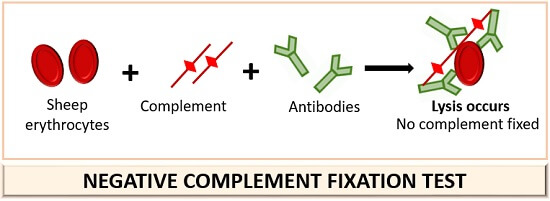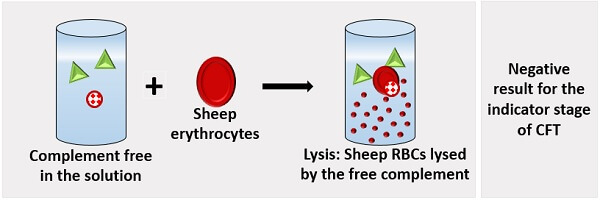A complement fixation test is a serological assay used to detect antibody or antigen in the patient’s serum by using a complement. A complement participates in the immunological reaction and particularly binds with the antibody. Without antibodies, a complement may lyse the erythrocytes.
A complement fixation test is a very complex process, which requires five reagents with separate standardization. CF serological assay involves the preparatory, complement fixation and indicator stage.
A complement fixation test requires an antigen, antibody, complement, sheep erythrocytes and amboceptor to perform the analysis. Here, you will get to know the definition, principle, procedure and types of the complement fixation test.
Content: Complement Fixation Test
Definition of Complement Fixation Test
Complement fixation test is an immunological test, which uses complement to detect the presence of antigen (about 0.04-0.06 mg) or antibodies (about 0.1 mg). CFT uses complement as a test system, which only fixes to the immunological complex or antigen-antibody complex. The complement causes immune cytolysis or the lysis of antibody-coated cells.
A complement remains free when there is no antibody in the test sample and results in erythrocytes lysis. If a complement fixes with the antibody, it does not cause hemolysis. CFT also uses sheep erythrocytes as an indicator system that particularly binds with the immunoglobulin-G (in the patient’s serum).
Principle
Complement fixation test depends upon the principle of fixing complement to the antigen-antibody complex. Its principle is not based on the haemagglutinating activity. To perform CFT, you should use the serum (free of anticomplementary activity).
CFT depends upon two different systems, namely test and indicator system. A test system includes antigen, antibody and a complement. The indicator system involves the addition of sheep erythrocytes to test whether a free complement is present or not.
If there will be specific binding between an antigen and antibody, a complement will fix with the Ag-Ab complex. Conversely, a complement will remain free and lyse the sheep RBCs in case of antibodies absence. There are two ways to perform a complement fixation test, namely positive and negative complement fixation test.
In a positive CFT, a complement fixes with the antigen-antibody complex, and no hemolysis occurs.

Oppositely, a complement does not fix due to the absence of antibody and hemolysis occurs in a negative CFT.

Procedure of Complement Fixation Test
There are three steps or stages to perform a complement fixation test, which includes:
Preparatory Stage
It is the first stage of the complement fixation test, where all the reagents are standardized before performing the experiment. CFT requires an antigen, inactivated patient’s serum, a complement and an indicator system (sheep erythrocytes).
First, take a soluble or particulate antigen. Then, take an antiserum and heat it to 56 degrees Celsius for half an hour before the complement fixation to remove anticomplementary agents. Take a complement from the source of guinea pig serum and preserve it either in a lyophilized or frozen state.
Before proceeding with the test, the standardization of the reagents is necessary. Titrate the guinea pig complement to the minimum haemolytic dose. The MHD of guinea pig serum is considered to be the highest dilution of guinea pig serum, which can lyse about one unit volume of sheep erythrocytes in the presence of excess amboceptor under 37 degrees temperature. It takes 30-60 minutes.
One MHD of amboceptor is considered to be the highest dilution of inactivated amboceptor which can lyse about one unit volume of sheep erythrocytes in the presence of excess complement under 37 degrees temperature. It takes 30-60 minutes. In CFT, saline added with calcium and magnesium ion is used to titrate complement and amboceptor.
Complement Fixation Stage
It is the stage after the reagents’ preparation, in which a complement fixes with the immunogenic complex (Ag-Ab complex). In the complement fixation stage, you need to incubate an antigen, inactivated patient’s serum and a standardized complement.
Positive result: A specific binding between the antibodies and antigens activates a complement. As a result, a complement will attach to the antigen and antibody complex and gives a positive result for the complement fixation stage.

Negative result: If there is no such binding between antigens and antibodies, a complement will remain free in the solution and gives a negative result for the complement fixation stage.

Indicator Stage
It is the third stage, which detects the presence of free complement. Add sheep erythrocytes to the above mixture containing the antigens, patient’s serum and a complement.
Positive result: If lysis of sheep erythrocytes does not occur, the complement fixes with the antigen and antibody complex and gives a positive result for the CFT.

Negative result: Lysis of sheep erythrocytes indicates the presence of free complement and gives a negative result for the CFT.

Types of CFT
We can opt for one of the following methods to perform a complement fixation test:
Wasserman Test
It is a routine assessment for the serological diagnosis of Syphilis. In Wassermann reaction, incubate a test serum of the patient for one hour at 35-37 degrees Celsius. After incubation, mix the serum with the test antigens and two units of guinea pig complement.
The presence of syphilitic antibodies in the serum will bind to the specific test antigens, and a complement will fix with the antigen-antibody complex. There will be no antigen-antibody formation if the serum lacks syphilitic antibodies, and the complement will remain free in the solution.
Take sensitized sheep erythrocytes and coat them with 4MHD hemolysin to detect the presence of antibodies in the serum. Then, the whole mixture is incubated at 35-37 degrees Celsius for 30 minutes.
- Negative CFT: Lysis of sheep erythrocytes will indicate no complement fixation and the absence of antibodies.
- Positive CFT: In this, the lysis of sheep erythrocytes does not occur. The absence of hemolysis will indicate the fixation of complement and the presence of antibodies.
Indirect Complement Fixation Test
This method is used to check the avian and mammalian serum, which do not fix the complement of guinea pig. The indirect method involves two series of test. First, the standard antiserum fixes with the complement and the test antigen will get utilized.
The subsequent addition of antiserum will not fix the complement. Thus, in the indirect complement fixation test, hemolysis of sheep erythrocytes indicates a positive result.
Conglutinating Complement Adsorption Test
It is an alternative method for the system, which cannot fix the complement of guinea pig. Conglutinating complement adsorption test uses non-haemolytic horse compliment as an alternative to the guinea pig. After that, you need to mix the sensitized sheep erythrocytes with the bovine serum.
A bovine serum acts as an antibody (contains a beta globulin component) known as “Conglutinin”. Thus, bovine serum agglutinates the sheep erythrocytes once it binds with the horse complement through a process called “Conglutination”.
If the formation of antigen and antibody complex occurs, then the horse compliment will get utilized, and agglutination of sheep erythrocytes will not occur.
I read your blog. It is having very useful information that helps me a lot. I will read more articles on your blog.
I read your blog. It’s having very useful information that helped me a lot. I will read more articles on your blog.